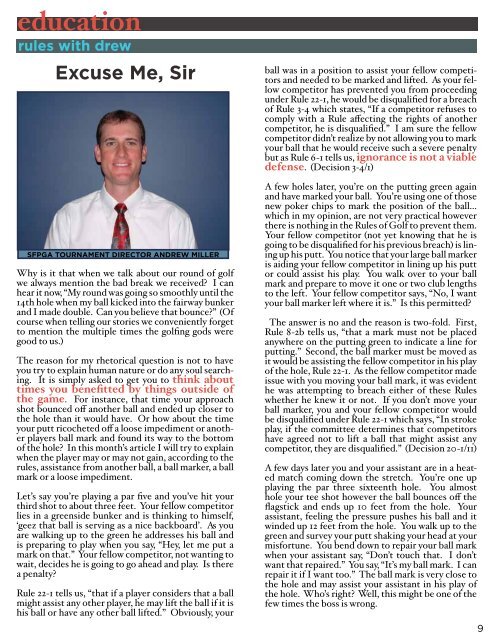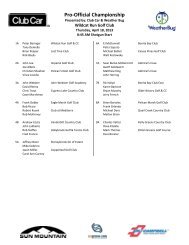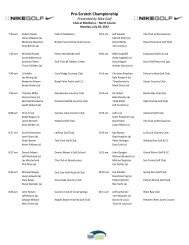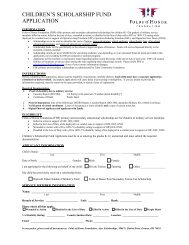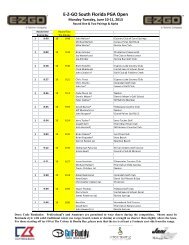TOPICS NEWSLETTER - South Florida PGA Golf
TOPICS NEWSLETTER - South Florida PGA Golf
TOPICS NEWSLETTER - South Florida PGA Golf
Create successful ePaper yourself
Turn your PDF publications into a flip-book with our unique Google optimized e-Paper software.
education<br />
rules with drew<br />
Excuse Me, Sir<br />
SF<strong>PGA</strong> Tournament Director Andrew Miller<br />
Why is it that when we talk about our round of golf<br />
we always mention the bad break we received? I can<br />
hear it now, “My round was going so smoothly until the<br />
14th hole when my ball kicked into the fairway bunker<br />
and I made double. Can you believe that bounce?” (Of<br />
course when telling our stories we conveniently forget<br />
to mention the multiple times the golfing gods were<br />
good to us.)<br />
The reason for my rhetorical question is not to have<br />
you try to explain human nature or do any soul searching.<br />
It is simply asked to get you to think about<br />
times you benefitted by things outside of<br />
the game. For instance, that time your approach<br />
shot bounced off another ball and ended up closer to<br />
the hole than it would have. Or how about the time<br />
your putt ricocheted off a loose impediment or another<br />
players ball mark and found its way to the bottom<br />
of the hole? In this month’s article I will try to explain<br />
when the player may or may not gain, according to the<br />
rules, assistance from another ball, a ball marker, a ball<br />
mark or a loose impediment.<br />
Let’s say you’re playing a par five and you’ve hit your<br />
third shot to about three feet. Your fellow competitor<br />
lies in a greenside bunker and is thinking to himself,<br />
‘geez that ball is serving as a nice backboard’. As you<br />
are walking up to the green he addresses his ball and<br />
is preparing to play when you say, “Hey, let me put a<br />
mark on that.” Your fellow competitor, not wanting to<br />
wait, decides he is going to go ahead and play. Is there<br />
a penalty?<br />
Rule 22-1 tells us, “that if a player considers that a ball<br />
might assist any other player, he may lift the ball if it is<br />
his ball or have any other ball lifted.” Obviously, your<br />
ball was in a position to assist your fellow competitors<br />
and needed to be marked and lifted. As your fellow<br />
competitor has prevented you from proceeding<br />
under Rule 22-1, he would be disqualified for a breach<br />
of Rule 3-4 which states, “If a competitor refuses to<br />
comply with a Rule affecting the rights of another<br />
competitor, he is disqualified.” I am sure the fellow<br />
competitor didn’t realize by not allowing you to mark<br />
your ball that he would receive such a severe penalty<br />
but as Rule 6-1 tells us, ignorance is not a viable<br />
defense. (Decision 3-4/1)<br />
A few holes later, you’re on the putting green again<br />
and have marked your ball. You’re using one of those<br />
new poker chips to mark the position of the ball...<br />
which in my opinion, are not very practical however<br />
there is nothing in the Rules of <strong>Golf</strong> to prevent them.<br />
Your fellow competitor (not yet knowing that he is<br />
going to be disqualified for his previous breach) is lining<br />
up his putt. You notice that your large ball marker<br />
is aiding your fellow competitor in lining up his putt<br />
or could assist his play. You walk over to your ball<br />
mark and prepare to move it one or two club lengths<br />
to the left. Your fellow competitor says, “No, I want<br />
your ball marker left where it is.” Is this permitted?<br />
The answer is no and the reason is two-fold. First,<br />
Rule 8-2b tells us, “that a mark must not be placed<br />
anywhere on the putting green to indicate a line for<br />
putting.” Second, the ball marker must be moved as<br />
it would be assisting the fellow competitor in his play<br />
of the hole, Rule 22-1. As the fellow competitor made<br />
issue with you moving your ball mark, it was evident<br />
he was attempting to breach either of these Rules<br />
whether he knew it or not. If you don’t move your<br />
ball marker, you and your fellow competitor would<br />
be disqualified under Rule 22-1 which says, “In stroke<br />
play, if the committee determines that competitors<br />
have agreed not to lift a ball that might assist any<br />
competitor, they are disqualified.” (Decision 20-1/11)<br />
A few days later you and your assistant are in a heated<br />
match coming down the stretch. You’re one up<br />
playing the par three sixteenth hole. You almost<br />
hole your tee shot however the ball bounces off the<br />
flagstick and ends up 10 feet from the hole. Your<br />
assistant, feeling the pressure pushes his ball and it<br />
winded up 12 feet from the hole. You walk up to the<br />
green and survey your putt shaking your head at your<br />
misfortune. You bend down to repair your ball mark<br />
when your assistant say, “Don’t touch that. I don’t<br />
want that repaired.” You say, “It’s my ball mark. I can<br />
repair it if I want too.” The ball mark is very close to<br />
the hole and may assist your assistant in his play of<br />
the hole. Who’s right? Well, this might be one of the<br />
few times the boss is wrong.<br />
9


